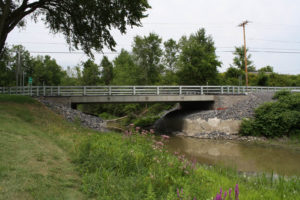
Geosynthetic reinforced soil–integrated bridge system (GRS–IBS) technology—part of all three rounds of Every Day Counts (EDC)—is developing a track record.
“Before GRS–IBS was named an EDC technology in 2010, we had a few projects in a few counties,” said Daniel Alzamora, FHWA geotechnical engineer and leader of the EDC-3 GRS-IBS Innovation Deployment Team.
Now the number of GRS–IBS structures nationwide is approaching 300. Eight states have adopted GRS–IBS technology as a standard practice. Another 26 states, Washington, D.C., Puerto Rico, and Federal Lands Highways have used GRS–IBS on projects or are preparing to deploy the technology.
GRS–IBS uses alternating layers of compacted granular fill material and layers of geosynthetic reinforcement to support bridges. The technology integrates the roadway approach to the bridge, eliminating the bump drivers commonly feel between the road and bridge.
“We’re promoting this technology because we’re seeing lower costs and faster construction time, we’re using readily available materials and equipment, and we’re eliminating that bump at the end of the bridge,” said Alzamora.
GRS–IBS has been used successfully on a variety of crossing types and roadway geometries with different kinds of superstructures, facings, fill materials, and geosynthetics. Both agency staff members and contractors are designing and building GRS–IBS structures.
“If you haven’t tried this technology and you would like to, you would be in good company,” said Alzamora.
Source: March/April 2016 FHWA Innovator
 TEXTILES.ORG
TEXTILES.ORG


